Missing Malaysia Airlines Flight MH 370: New signal detected by search crew beyond 30-day deadline for 'black box' batteries
Debris search area has been narrowed as Ocean Shield continues to try and pinpoint the plane's fading 'black box' pinger

As the search area being scoured for the missing Malaysia Airlines flight MH370 was hugely narrowed this morning, officials said they had detected a further signal believed to be from the plane's “black box” flight recorders.
Angus Houston, the head of the joint agency coordinating the hunt for the Boeing 777, said the new signal had been reported by an Australian P-3 Orion aircraft that has been dropping sound-locating buoys into the refined search area.
“The acoustic data will require further analysis overnight,” Houston said, adding that it shows the “potential to be from a man-made source”.
A team consisting of 13 ships and 14 planes was tasked on Thursday with looking for floating debris in a 22,300 square-mile (57,900 square-km) stretch of the southern Indian Ocean – the smallest so far.
Near that zone is a relatively tiny 500 square-mile (1,300 square-km) patch where, it is believed, the plane’s “black box” flight recorders are resting on the ocean floor.
Angus Houston, the head of the joint agency coordinating the hunt for the Boeing 777, said the Australian navy vessel Ocean Shield was there today trying to relocate signals “pinged” from the wreckage.
At the same time, Royal Australian Navy Commodore Peter Leavy explained, each buoy dropped from aircraft is dangling a hydrophone listening device about 1,000ft (300m) below the surface.
Yesterday Houston said: “I'm now optimistic that we will find the aircraft, or what is left of the aircraft, in the not too distant future.”
A document released on Thursday by the Australian government said that while the black boxes’ batteries for sending out locator signals were designed to last for 30 days, it was likely that the acoustic pingers “would continue to transmit at decreasing strength for up to 10 more days”.
Houston, a retired air force chief, said in a briefing on Wednesday that the signals seemed to have faded noticeably between Saturday and when they were relocated on Tuesday.
But he said: “Hopefully in a matter of days, we will be able to find something on the bottom that might confirm that this is the last resting place of MH370.”
The authorities want to keep narrowing in on a more precise location for the black boxes before they drop a submersible search vessel, which takes six times longer to cover the same area as the pinger locator dragged by Ocean Shield.
Once it becomes clear there is no hope of picking up further acoustic signals, the unmanned submarine Bluefin 21 will be sent down to search the sea floor.
Complicating matters, however, is the depth of the seafloor in the search area. The pings are emanating from 4,500 meters below the surface — which is the deepest the Bluefin 21 can dive.
“It'll be pretty close to its operating limit. It's got a safety margin of error and if they think it's warranted, then they push it a little bit,” said Stefan Williams, a professor of marine robotics at Sydney University.
Williams said it was unlikely that the wreck had fallen into the narrow Diamantina trench, which is about 5,800 meters (19,000 feet) deep, since sounds emanating from that depth would probably not have been detected by the pinger locator.

Malaysia Airlines Flight 370, carrying 239 people on board, went missing on 8 March en route from Kuala Lumpur to Beijing, beginning one of aviation's biggest mysteries.
The search has shifted from waters off of Vietnam, to the Strait of Malacca and then finally to waters in the southern Indian Ocean as data from radar and satellites was further analysed.
Join our commenting forum
Join thought-provoking conversations, follow other Independent readers and see their replies
Comments